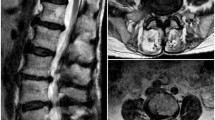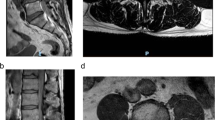Abstract
Most symptomatic lumbar disc herniations occur in a postero-lateral direction. Disc fragments also commonly migrate both caudally and rostrally. The extrusion of lumbar discs is usually limited by the posterior longitudinal ligament and its attachments. Migration of disc tissue around the dural sac to the posterior epidural space is a rare occurrence. There have been even fewer reports, in the published literature, of cauda equina syndrome resulting from posterior epidural migration of lumbar disc fragments. We present a case of cauda equina syndrome due to compression of the neural elements by a large fragment of sequestered lumbar disc tissue, which had migrated to the posterior epidural space.
Résumé
La plupart des hernies discales lombaires sont postéro-latérales. Les fragments discaux migrent habituellement soit vers la bas, caudalement, soit vers le haut. L’extériorisation des hernies est limité classiquement par les attaches du ligament vertébral commun postérieur. En fait la migration de fragments discaux autour du sac épidural est plutôt rare. C’est pourquoi il y a peu de publications de syndrome de la queue de cheval par des migrations en arrière vers le sac épidural. Nous décrivons un tel cas.


Similar content being viewed by others
References
Ahn UM, Ahn NU, Buchowski JM, Garrett ES, Sieber AN, Kostuik JP (2000) Cauda equina syndrome secondary to lumbar disc herniation: a meta-analysis of surgical outcomes. Spine 25(12):1515–1522
Bonaroti EA, Welch WC (1998) Posterior epidural migration of an extruded lumbar disc fragment causing cauda equina syndrome. Clinical and magnetic resonance imaging evaluation. Spine 23(3):378–381
Dosoglu M, Is M, Gezen F, Ziyal MI (2001) Posterior epidural migration of a lumbar disc fragment causing cauda equina syndrome: case report and review of the relevant literature. Eur Spine J 10(4):348–351
Kostuik JP, Harrington I, Alexander D, Rand W, Evans D (1986) Cauda equina syndrome and lumbar disc herniation. J Bone Joint Surg Am 68(3):386–391
Kuzeyli K, Cakir E, Usul H, Baykal S, Yazar U, Karaarslan G, Arslan E, Peksoylu B (2003) Posterior epidural migration of lumbar disc fragments: Report of three cases. Spine 28(3):E64-E67
Mixter WJ, Barr JS (1934) Rupture of the intervertebral disc with involvement of the spinal cord. N Engl J Med 211:210–215
Neugroschl C, Kehrli P, Gigaud M, Ragragui O, Maitrot D, Manelfe C, Dietemann JL (1999) Posterior extradural migration of extruded thoracic and lumbar disc fragments: role of MRI. Neuroradiology 41(9):630–635
Robe P, Martin D, Lenelle J, Stevenaert A (1999) Posterior epidural migration of sequestered lumbar disc fragments. Report of two cases. J Neurosurg [Suppl 4] 90:264–266
Schellinger D, Manz HJ, Vidic B, Patronas NJ, Deveikis JP, Muraki AS, Abdullah DC (1990) Disk fragment migration. Radiology 175(3):831–836
Sekerci Z, Ildan F, Yuksel M, Gul B, Kilic C (1992) Cauda equina compression due to posterior epidural migration of extruded lumbar disk. Neurosurg Rev 15(4):311–313
Author information
Authors and Affiliations
Corresponding author
Rights and permissions
About this article
Cite this article
Walsh, A.J., Martin, Z. & McCormack, D. Cauda equina syndrome secondary to posterior epidural migration of a lumbar disc fragment: a rare phenomenon. Eur J Orthop Surg Traumatol 14, 30–31 (2004). https://doi.org/10.1007/s00590-003-0124-z
Received:
Accepted:
Published:
Issue Date:
DOI: https://doi.org/10.1007/s00590-003-0124-z




